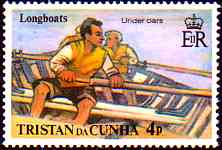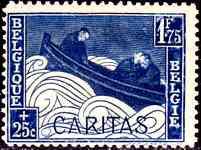|
Maritime Topics on Stamps:
|
|
Moby Dick, Myth and Truth!
|
|

|

|
|
From the beginnings of time man was fascinated by large whales with their massive bodies. Many legends and
myths describe these enormous animals. Old prints sometimes show whales with two trunks, spouting water into the air.
This stamp depicts a ship's crew defending itself against two whales throwing barrels at the animals.
|
Hermann Melville's novel 'Moby Dick' is based on true occurences.
There was a sperm whale the whalers called 'Mocha Dick', named 'Mocha' as
the animal's first attack happened off the Mocha Islands in Chile. It had an eight feet long white
scar across its head. Between 1810 and 1859 this whale destroyed dozens of boats and even attacked large ships.
In 1830 a chronist wrote that Mocha Dick's skin were 'white as wool'.
In 1820 the bark 'Essex' was sunk by a sperm whale that might have been
'Mocha Dick'. These two events inspired Herman Melville to write his novel 'Moby Dick'.
|

|

|
The American writer Herman Melville lived from 1819 to 1891. For three
years he served as a sailor on whaling ships. He also sailed on the frigate 'United States' of the U.S.
Navy. Melville wrote very realistically and with a poetic, religious and prophetic touch. He authored five
successful novels about seafaring and life in the South Seas. After reading chief mate Owen Chase's account of the
voyage of the 'Essex', he wrote 'Moby Dick' which was published in 1851.
At left we see Melville on the Polynesian stamp, on top right on a postcard with his white whale 'Moby Dick'.
|

|

|
To the novel:
A white boy named Ismael and his black friend Quiqueg, a harpooner,
sign on to the whaler 'Pequod' in Nantucket. The ship's commander is captain Ahab, who has only one leg (right
stamp). The other one was torn off by 'Moby Dick', the white whale. Now he has a peg leg fitted from the
bone of a sperm whale. Nasty rumors surround this mysterious captain. Ismael hears of a prediction that "all men will
smell land where there is none, and the Pequod will be lost at sea. Ahab will die, the rise from the dead and all
sailors except one will follow him into the grave!"
|

|
During the voyage it turns out that captain Ahab is not interested in normal
whaling. His only purpose is the search for a certain whale, 'Moby Dick'. He nails a golden coin to the mast, a reward
for the first one to sight the white whale. Then the crew must swear: "death to the white whale!" Although they catch
some whales in the following weeks, 'Moby Dick' is not among them. But one day in the Pacific 'Moby Dick'
is sighted (stamp at left). The boats are lowered and the hunt begins. But the white whale dives and disappears.
However,
Ahab has drawn himself a chart showing all positions where 'Moby Dick' has been sighted. He knows what direction
'Moby Dick' will choose.
|

|

| |
They meet several other whalers who had sighted 'Moby Dick' but were
unable to harpoon him. Captain Ahab and his 'Pequod' madly keep pursuing the white whale, even
ignoring another whaling captain's plea to assisit in the search for the skipper's son who went adrift in a boat. Ahab's
blind hate of 'Moby Dick' surpasses his concern for human lives. And then, finally, comes the day he catches up with
'Moby Dick'. With three boats he sets out to attack the animal. Ahab himself hurls a harpoon into 'Moby Dick's' body
(stamps above).
|

|
But then he gets tangled up in the harpoon's line and once 'Moby Dick' starts a deep dive Ahab is
pulled down into the sea. As foretold, Ahab does emerge again but is constricted within the whale's body. When
harpoons are thrown from the other two boats the whale smashes them with his powerful tail fluke (stamp at left).
Next, he turns against 'Pequod' and rams her twice. The hull is broached and the vessel sinks.
Ismael, hanging on to
some flotsam, is the only one to be saved by a passing whaler.
|

|
Some data regarding the 'Essex':
- Wooden three-masted bark, whaling vessel
- built around 1800 in Nantucket, Massachusetts
- L * B * T = approx. 92 ft * 26 ft * 16 ft
- 238 tons loading capacity
- crew 21 men.
- three boats for the whale hunt
The 'Essex' was a small, but durable ship. At the time of her last trip she looked back on19 successful years in the
whaling business.
|

|

| |
On 12th August 1819 'Essex' sails from Nantucket for the whaling grounds in the Pacific.
Her captain is George Pollard, 29 years old. Chief mate Owen Chase, 22, is keeping the ship's log and, in later
years, will write a book about the voyage.
The crew is enduring heavy storms rounding the Horn, reaching the Peruvian coast in 1820. They catch some 20
whales (stamps above) and continue to the Galapagos. Here they fill up their provisions with several hundred sea
turtles.
|

|

| |
On 20th November 1820 the ' Essex ' pursues a group of sperm
whales. After Owen Chase hurls a harpoon into a whale, the animal turns sideways and with its fluke delivers a
damaging blow to the boat. Chase cuts the rope with a hatchet and frees the boat. They plug the leak with their
jackets and row back to the ship. Hardly aboard, they observe an enormous 85 feet long sperm whale heading
directly towards the ship. The whale rams into the ship's side. Water flows into the hull of the 'Essex'. And then whale
returns! For a second time the whale's skull cracks into the ship. The 'Essex' begins to sink. With utmost haste the
crew transfers provisions, water, navigational instruments, masts, canvas, rifles and tools into the three boats. Then,
they steer a southeast course to reach the mainland of South America.
|
|
Now comes a time of sorrow and terror for the three boats. The sailors fight with storms,
an Orca attacks the captain's boat and damages the stem, supplies decrease rapidly. They endeavor
to catch rain water in the sails. The boats are blown off course to the west. They halve the rations. On 20th
December they reach uninhabited Henderson Island. Here they find a source of water, catch birds and crawfish, and
collect berries. Six days later they embark again but three sailors chose to remain on the island, feeling safer there
than at sea. Several days later these three encounter eight human skeletons in a cave!
|

|

|
Storms and rains separate Owen Chase's boat from the other two. The food supply is diminishing. The men are
hungry and thirsty. Their strength is ebbing, several start hallucinating. The three boats see five men perish during the
following weeks. The survivors carve them up and eat them. In one of the boats the men draw lots to determine who
is going to be killed for food. The ships boy is the loser. He is shot and eaten.
On 28th January Captain Pollard loses contact with the third boat. It was never seen again.
|
|
On 18th February 1821, after three months marooned in the Pacific, chief mate Owen Chase's boat is discovered
by the sailing ship 'Indian' and three exhausted survivors are hauled aboard. Five days later, captain Pollard and
another sailor are saved by the whaler 'Eagle'.
The three sailors on Henderson Island are taken aboard a trading vessel at the beginning of April.
Altogether, eight men of the 'Essex' survived, thirteen died. Upon the survivors' return to Nantucket people are
horrified by the tales of cannibalism, yet nobody raises any accusations against them.
|

|
During the summer Owen Chase writes the book with the following long title: "Narration of the most unusual and
shaking sinking of the 'Essex', a whaler from Nantucket, which was attacked in the Pacific Ocean by a sperm whale
and finally sunk, including a report of the incomparable suffering of the captain and crew during 93 days in open
boats in the years 1819 and 1820."
By the time the book is published, Chase is again at sea chasing whales. In later years he becomes a well-known
whaling captain. 20 years later, aboard the 'Acushnet', the sailor Herman Melville reads this book finishing it in one
night. It inspires him to write 'Moby Dick or the White Whale', which has been called one of the greatest novels of
American literature.
|

|
Back to the true 'Mocha Dick'.
He was killed by a Swedish whaler in 1859. At the time he was reported
feeble with age and blind in one eye, lacking the strength to resist. 19 weapons were discovered in his skin,
scattered by many scars. During more than 100 attacks, he had destroyed numerous boats and several large barks
like the 'Essex', causing the death of at least 30 sailors.
|
|
There were more ships sunk by whales besides the 'Essex'. The most
famous 'fighting whales' who defended their herds in self-defence are known to have been named 'Mocha Dick',
'Timor Jack' and 'New Zealand Tom'. Usually, they destroyed just the ship's boats, but also large sailing ships like the
'Essex' (1820), 'Pusie Hall' (1835), 'Two Generals' (1838), 'Pocahontas' (1850) and 'Ann Alexander' (1851).
And off the Japanese coast a whale was reported to have attacked four ships and sinking two of them!
|

|
Sources: Gary Kinder, Verloren im Pazifik (Lost in the Pacific), GEO Nr. 6, 2000
Lutz Bunk, 50 Klassiker, Schiffe (50 classics, ships)
A.B.C. Whipple, Die Walfänger (The Whalers), Time Life Books
some stamp scans by Klaus Reinhardt.
|
|